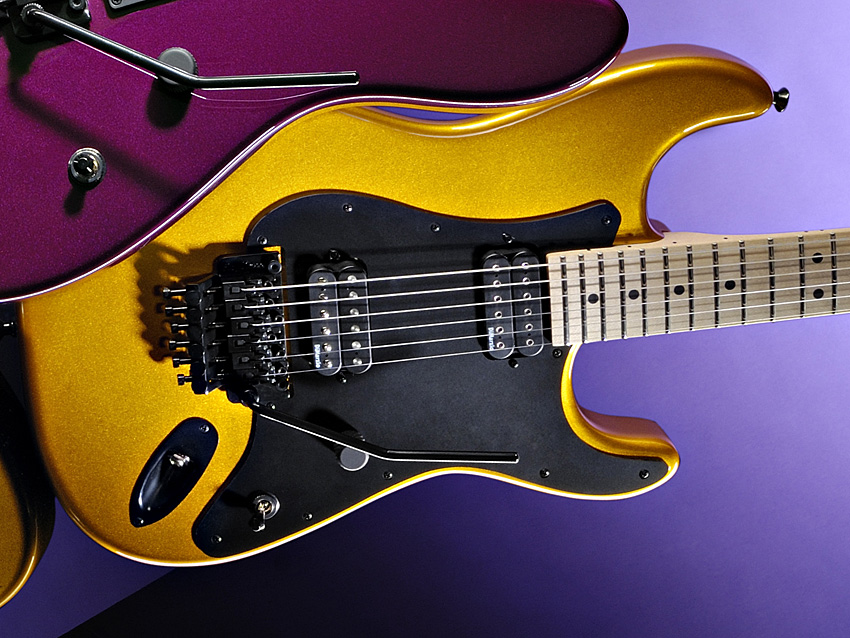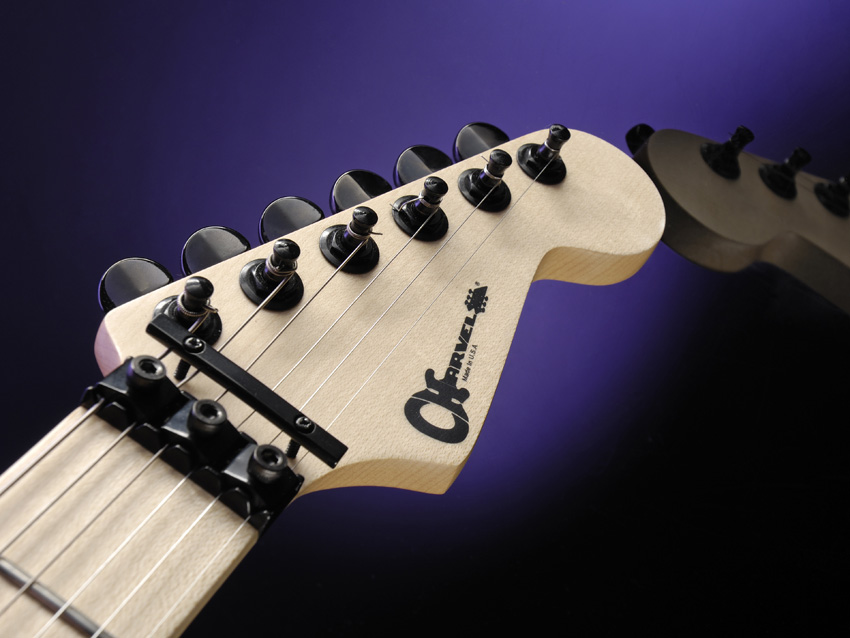MusicRadar Verdict
Too offer a guitar with a slight variance in spec is a good move by Charvel. Great neck, cool vibe, and the body is routed for a central single-coil should you wish to go down that route.
Pros
- +
The Dimarzio pickups' aggressive voice. Great finish. Ultra-comfortable neck.
Cons
- -
Nothing.
MusicRadar's got your back

Charvel So-Cal Style 1

Charvel So-Cal Style 1
The Southern Californian towns of Glendora and San Dimas, just 30 miles or so east of downtown Los Angeles, are inauspicious locations for an important shift in the electric guitar world.
Wayne Charvel set up what was to become a legendary repair and customising facility there in the mid-seventies, initially in San Dimas before moving to Glendora in 1980.
Although the name seems, on the face of it, to owe its existence largely to the skills of Wayne Charvel, it should be noted that the history books show that Grover Jackson did as much as anyone to keep the brand afloat back in the day.
We have on several occasions written of the time when a young Edward Van Halen walked into Wayne's repair shop in 1974 and put together an instrument from a Boogie Bodies neck and body upon which he'd go on to virtually reinvent the electric guitar, but it's the feel, the tone and the vibe that was inherent within the vast majority of guitars bearing the distinct logo of Charvel Manufacturing that caught the imagination of so many players.
"With a hefty DC resistance of 17.3k ohms, the bridge Tone Zone gives a wide, punchy and full-on rock rhythm tone."
It'd be fair to say that Charvel was the first company to popularise the idea of a wholly custom-made guitar for the rocking masses and, as was the prevailing wind in Southern California at the time, the more outrageous the design of your guitar the more likely your band was to be noticed.
Names associated with the brand read like a who's who of US custom building: there's Wayne and Grover, as well as Larry DiMarzio, Boogie Bodies' Lynn Ellsworth, Mike Eldred, and David Schecter.
If you can find an original 1979 'Prepro' model on Ebay, expect to shell out several grand; even original neck plates are topping £400!
Want all the hottest music and gear news, reviews, deals, features and more, direct to your inbox? Sign up here.
Since Fender MIC bought the entire collection of Jackson/Charvel brands from Akai in 2002, players and fans alike have been waiting with baited breath for some affordable yet authentic revamps of the classic late-seventies Charvel hotrod. Now, finally, the release of these three USA Production Models represents an end to that wait.
The Guitars
Check out the So-Cal Style 1 in action in the following video, alongside the San Dimas Style 2:
"The Charvel is the hotrod guitar," says Charvel's Mick McGregor. "If you think about it, Charvel was the original blasphemy of the Fender Stratocaster.
"In the late seventies the major manufactures weren't addressing the needs of a key group of players: these guys were looking for faster, more comfortable necks. They were looking for Stratocaster bodies [loaded] with humbuckers.
"This was the birth of the original Custom Shop - Charvel. These instruments have a clear lineage to those early shred machines and the new USA Production Model Series comes with all the mods a player is typically looking for."
The new guitars comprise a pair of Strat-types, the San Dimas Style 1 and this So-Cal Style 1, plus the Tele-type San Dimas Style 2. As the original idea behind Charvel was to streamline and modernise Leo Fender's original designs to players' tastes, just how different are these from their obvious influences?
"There are large differences," says McGregor. "The edge radius [to the body], contours and overall size have been refined to the needs of Charvel players throughout the years.
"We gathered up countless Custom Shop guitars, some new, some old and we spec'd out the necks and bodies. We then pulled up the countless work orders going back to the late seventies as we were trying to find out what were the most requested specifications; two humbuckers, an alder body, a maple neck with a compound radius, a Floyd Rose and so on."
We'll get to the intricacies of the specs in a tick, but the single thing that lets you know that this is a real Charvel as soon as you pick it up (aside from that wonderfully simple logo) is the neck.
Made here from a single piece of quartersawn maple, the unblemished feel and sheer playability is similar to the £16,000 EVH Frankenstein Replica, which is no surprise, as that's pretty much the vibe these guitars are aiming for.
When Ed put the original together on the floor of Wayne Charvel's shop, this is what it must have felt like - and that's real history.
"You'll see subtle differences as a result of hand-sanding but, essentially, they're the same neck," explains McGregor. "This is because the neck is what makes a Charvel. The necks and bodies are hand-sanded and shaped after being pretty well defined on a CNC."
Each neck is the same and offers a 305-406mm (12-16-inch) conical radius and a slight pitch - the angle of the neck in relation to the body and bridge - for a super-smooth action: 1.53 degrees in the case of this So-Cal.
The guitar is loaded with two DiMarzio humbuckers controlled by a three-way toggle switch and a single volume control. Historians tell us that the very first Charvels were loaded with DiMarzio Super Distortion and PAF models, and then with Duncan models later on, which included the first examples of the now classic JB humbucker.
A perfectly set-up double-locking Floyd Rose is a prerequisite for most Charvels produced then and now, and the locking nut here is the version that can be screwed into the neck without the need for bolts that actually run all the way through the wood.
The outrageously over-the-top candy finish is also part of the style and Charvel intends to issue further loud and proud colours on later production runs, which will supersede and replace finishes that have gone before.
In other words, if you love this pagan gold hue, you'll need to move quickly before it disappears back into the vault. It's an interesting ploy and your local Fender or Charvel dealer should be able to give you the precise ins and outs.
Sounds
With a quality valve amp, especially one intended for rock use, we're happy to report that you can really hear the wood resonating through your speakers: our Mesa Lonestar has rarely had to deal with such heat.
The So-Cal has an aggressive voice. The two DiMarzios are each hotter than the Seymour Duncan counterparts used in Charvel's San Dimas models and, with a hefty DC resistance of 17.3k ohms, the bridge Tone Zone gives a wide, punchy and full-on rock rhythm tone.
To our ears it's smoother with more middle than the original's Super Distortion, and winding up the gain simply increases the quality of the sound rather than the level of mush.
Compared to the more glassy tone offered by the Duncan SH-1 in the neck position of both San Dimas guitars, the output of the ceramic magnet, coupled with a more modest general output, gives the neck Evolution a traditionally flavoured sound with which Gibson SG players will be familiar.
The Floyd stays perfectly in tune as long as the strings have been strenuously stretched-in, and the necks play just as nicely in battle as they do when you're idly strumming in front of the television.
If you were a UK-based rock guitar player during the eighties, you would have dreamt of perhaps one day owning an original Charvel. Well, that day has arrived and the only thing that separates these three from an original model from 1978 is the unavoidable march of time.
The hotrod vibe, thanks to the stripped-down look and candy finishes, is front and centre and, as we've said, the necks are truly things of wonder, the feel of which belies what is certainly a modest price tag.
This ticks all the boxes for rock and pop styles, especially all-out wang-bar madness. Go wail!
Simon Bradley is a guitar and especially rock guitar expert who worked for Guitarist magazine and has in the past contributed to world-leading music and guitar titles like MusicRadar (obviously), Guitarist, Guitar World and Louder. What he doesn't know about Brian May's playing and, especially, the Red Special, isn't worth knowing.